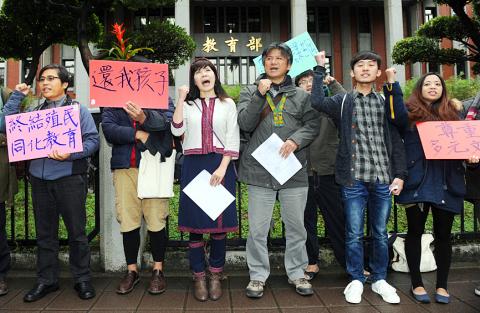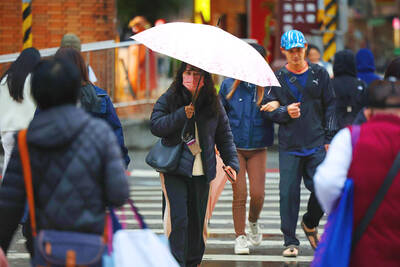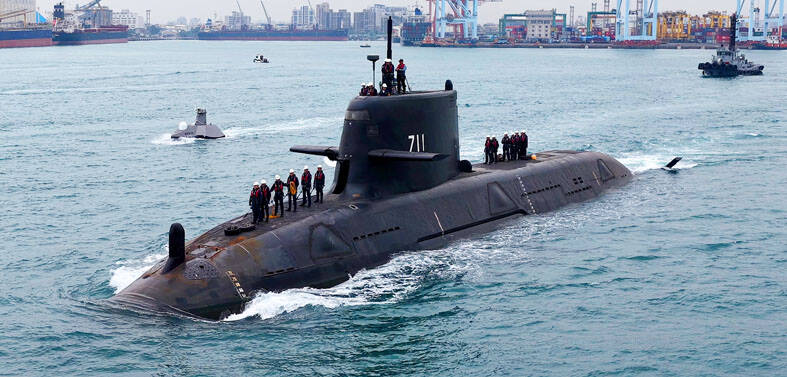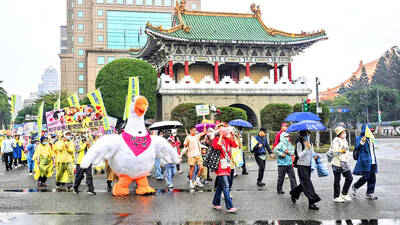A group of Aborigines yesterday protested in front of the Ministry of Education (MOE) building in Taipei, calling for an end to what the protesters called colonial assimilation education and deploring the China-centered and Han-centered history perspective instilled by the Republic of China (ROC) government since its arrival in Taiwan in 1949.
The ministry’s recent announcement of adjustments to be made to the high-school history curriculum, and the way they were decided upon, have set off a furor among the political opposition parties and in education and culture circles.
More than a dozen Aboriginal awareness groups joined the protest yesterday, criticizing repression by “alien regimes, of which the ROC is the ongoing one,” and the continuing deprivation of Aboriginal people’s rights to their languages and lands.

Photo: Lo Pei-der, Taipei Times
“We spoke Japanese, but we were not imperial subjects; we speak Mandarin, but we are not yan huang zisun (炎黃子孫, descendants of emperors Yan and Huang),” Taiwan Aboriginal Society chairman Tibusungu Vayayana (汪明輝) said.
Yan huang zisun is a phrase used by the Chinese government and President Ma Ying-jeou (馬英九) to refer to a common ancestry among people of Chinese ethnicity.
“The 14 official Aboriginal tribes and those that have not been adequately recognized in Taiwan are not ‘the 56th ethnic minority group of China,’” he said, responding to a claim made by a member of the pro-China Anti-Independence-Oriented-History Front last week.
“We belong to the world’s indigenous community,” he said. “Studies have suggested that Taiwan was the place of origin of all Austronesian-speaking people.”
Tibusungu called for an autonomous education system for the Aboriginal people to “return the children back to their home in their native land,” citing the UN Declaration on the Rights of Indigenous Peoples, ROC Constitution and the Indigenous Peoples Basic Act (原住民族基本法), which affirm or vow to protect cultural plurality and indigenous people’s autonomy.
Pangcah/Amis Guarding Union representative Daong said the “Han-centered textbooks” oversimplify and largely ignore the history of the nation’s Aborigines.
“The history textbook, for example, talks about Qing official Shen Bao-zhen’s (沈葆楨) policy of ‘Opening up the Mountains and Pacifying the Aborigines’ (開山撫番), but fails to mention the Kaliawan Incident in 1877” that resulted in the near extinction of the Kebalan and Sakizaya tribes, he said.
He brought up a list of rebellions and battles involving Aborigines fighting against invasive regimes that are “unfamiliar even to the ears of children of the tribes involved.”
Huang Chih-huei (黃智慧), chairwoman of the Millet Foundation, which aims to promote and preserve Aboriginal cultures, criticized the ministry’s claim that the curriculum has to abide by the Constitution.
“The government touted the ROC’s 103th birthday this year. How transient that is compared with the whole history of Taiwan. Not to mention that the history of the ROC Constitution, promulgated in 1946, is even shorter,” she said. “The Constitution is a product of history, not the other way around. It is just preposterous to say that history-writing has to follow the Constitution.”
Atayal priest Omi Wilang said they were told when they were young to be “proud Chinese” and tribes were forced to take up Chinese last names.
Saying that the adjusted curriculum is again inculcating the anachronistic notion of “a monolithic ‘Chineseness,’” he accused the ministry of degenerating into a “political hatchet man.”
Kao Ming-chi (高明智) of the Katripulr tribe, representing the Taiwan First Nations Party — the political party formed in 2012 for the rights of Aborigines, said that “the ROC government has problems understanding us even when we have long been speaking their language.”

NUMBERS IMBALANCE: More than 4 million Taiwanese have visited China this year, while only about half a million Chinese have visited here Beijing has yet to respond to Taiwan’s requests for negotiation over matters related to the recovery of cross-strait tourism, the Tourism Administration said yesterday. Taiwan’s tourism authority issued the statement after Chinese-language daily the China Times reported yesterday that the government’s policy of banning group tours to China does not stop Taiwanese from visiting the country. As of October, more than 4.2 million had traveled to China this year, exceeding last year. Beijing estimated the number of Taiwanese tourists in China could reach 4.5 million this year. By contrast, only 500,000 Chinese tourists are expected in Taiwan, the report said. The report

Temperatures are forecast to drop steadily as a continental cold air mass moves across Taiwan, with some areas also likely to see heavy rainfall, the Central Weather Administration (CWA) said. From today through early tomorrow, a cold air mass would keep temperatures low across central and northern Taiwan, and the eastern half of Taiwan proper, with isolated brief showers forecast along Keelung’s north coast, Taipei and New Taipei City’s mountainous areas and eastern Taiwan, it said. Lows of 11°C to 15°C are forecast in central and northern Taiwan, Yilan County, and the outlying Kinmen and Lienchiang (Matsu) counties, and 14°C to 17°C

STEERING FAILURE: The first boat of its class is experiencing teething issues as it readies for acceptance by the navy, according to a recent story about rudder failure The Hai Kun (海鯤), the nation’s first locally built submarine, allegedly suffered a total failure of stern hydraulic systems during the second round of sea acceptance trials on June 26, and sailors were forced to manually operate the X-rudder to turn the submarine and return to port, news Web site Mirror Daily reported yesterday. The report said that tugboats following the Hai Kun assisted the submarine in avoiding collisions with other ships due to the X-rudder malfunctioning. At the time of the report, the submarine had completed its trials and was scheduled to begin diving and surfacing tests in shallow areas. The X-rudder,

DEMAND: The government should enact regulations in line with Austria and Germany to incorporate vegan nutrition into school meals, an advocate said More than 1,000 people yesterday marched in Taipei to promote veganism, calling for legislation to incorporate vegan diets into school lunches and the national net zero emissions program. Participants gathered on Ketagalan Boulevard in front of the Presidential Office Building for the march, which was organized by the Vegan Action Network (VAN). Former ambassador to Chad Chiu Chung-jen (邱仲仁), actor Yankee Yang (楊子儀) and actress Cindy Lien (連俞涵) attended the event. VAN member Marianne Chao (趙梅君) said that the campaign aimed to urge the government to promote vegan diets across schools and government agencies via legislation and national policies, which would help build